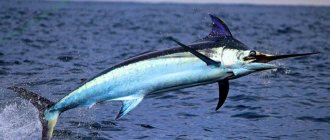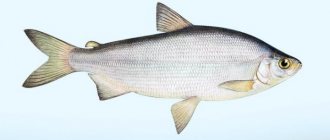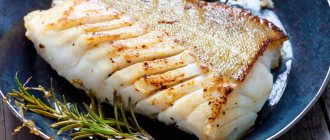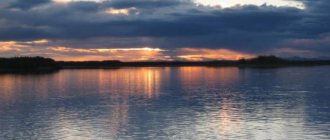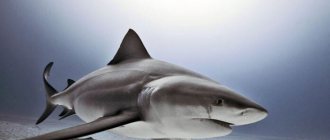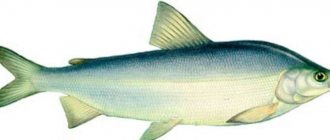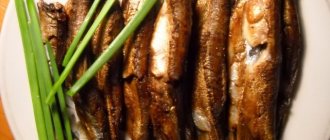Nelma
is a subspecies of fish of the whitefish genus, a family of whitefish that belongs to the order Salmonidae. Nelma is considered a semi-anadromous or freshwater fish. Its habitat extends to the Arctic Ocean basin, to the Mackenzie River from the Ponoi River. The fertility of nelma ranges from 125 to 420 eggs; this fish spawns in the fall (September-October) in fast places, where the bottom is sandy and pebble and the water temperature is from 3 to 8 ° C. Throughout the winter, eggs develop between the stones at the bottom. Already in the first year of life, nelma becomes a predator and feeds on vendace, smelt, juvenile perch carp fish and whitefish. Nelma is a valuable commercial fish, as well as an object of artificial breeding.
Nelma (migratory salmon) differs from salmon in its color, which does not have the characteristic dark spots. The body of the nelma itself is elongated and slightly flattened laterally. The color of the back is dark brown, the sides are light silver, the belly is white and the mouth is large with a significant number of small teeth. Nelma is a fairly large fish; in different habitat conditions its usual weight ranges on average from 5 to 16 kilograms, but there are individuals of thirty and forty kilograms.
Appearance
The mouth of the nelma is large, of course, the upper one. The lower jaw protrudes noticeably forward and curves sharply upward in front, in the form of a “tooth” it fits into the recess of the upper jaw. Its articulation with the skull lies behind the posterior edge of the eye. There are small teeth on the jaws, vomer and tongue. The body is not valval, but pike-shaped, laterally compressed. The color on the back is from dark green to light brown, on the belly and sides it is silvery. There are no dark transverse stripes on the body; the fins are dark.
There are two subspecies: whitefish from the Caspian Sea basin and nelma from the rivers of the Arctic Ocean. The origin of the species is Arctic. The whitefish entered the Caspian Sea from the Arctic Ocean basin during the Late Ice Age. Nelma reaches a length of 150 cm and a weight of 28 (occasionally up to 40) kg. whitefish - 130 cm and 14 kg. Maximum age is up to 22 years. The growth rate is very high compared to other whitefishes, but there is significant variability in growth rate and sexual maturation throughout its wide range, as well as large differences in the size and age structure of the population. Particularly rapid growth was noted in the whitefish.
Description of the fish
This is a large representative of the family and belongs to the subspecies of the whitefish. Lives in the Arctic Ocean basin, freshwater or anadromous fish. The external description of the nelma fish is well illustrated in the photo:
Main distinctive features:
- powerful spindle-shaped body;
- large silvery scales;
- the belly is white, the back is gray, there are no dark spots, like other representatives of the whitefish species;
- females and males look the same;
- during spawning, the color does not change; males may develop small tuberculate growths along the back and head;
- there is an adipose fin;
- eye color – light yellow;
- has a large terminal upper mouth, the lower one is larger than the upper one and protrudes forward, it has small sharp teeth that also cover the vomer and tongue;
- meat – white, fatty.
The average length of adult individuals usually does not exceed 70-80 cm, and weight varies between 5-12 kg.
Although often fishermen managed to catch fish more than 1 meter long. The weight of such large specimens can reach 40-50 kg. How do you most often cook fish?
- I fry 47%, 317 votes
317 votes 47%317 votes - 47% of all votes
- I bake 43%, 291 votes
291 votes 43%
291 votes - 43% of all votes
- Carcass 7%, 47 votes
47 votes 7%
47 votes - 7% of all votes
- Varya 3%, 20 votes
20 votes 3%
20 votes - 3% of all votes
Total votes: 675
16.09.2019
The lifespan of nelma is about 20 years, it may vary depending on the habitat. Predators feed on small fish (smelt, vendace, etc.) and young whitefish, carp and perch. They also do not pick at crustaceans, larvae, or insects. It hunts in the morning and evening, when fishermen catch it.
IMPORTANT: In the way of hunting, nelma is similar to sheresper. She also unexpectedly bursts into a school of small fish and stuns them with her powerful tail and fins.
The nelma population is rapidly declining due to massive fishing and deteriorating living conditions. Fish are sensitive to polluted water, which affects their reproduction. Work is underway to artificially rear and release young animals into the natural environment.
Spread of nelma
The bulk of nelma enters rivers from desalinated sea areas towards the end of June; the lower the water temperature, the higher the intensity of nelma migration. Having already entered the river, the fish stays close to the bottom and moves along the riverbed itself. When moving further along the river, nelma often rises to the surface of the water. Nelma avoids riffles and shallow waters and rests only in the deepest holes in the river bed. On the way to the spawning grounds, ascending the river, nelma destroys a huge number of different small fish. They catch nelma immediately after the opening of the rivers right up to spawning. After spawning, nelma goes to sea, although some individuals remain in the rivers for some time (from one to three years) and enter flood lakes in search of food.
Description
Nelma is one of the largest representatives of the whitefish genus.
Length up to 1.5 m and weight up to 50 kg. On average, individuals weighing 5-10 kg are more common. Semi-through view. Able to withstand water salinity up to 18-20 ppm.
The body is elongated, elongated, similar to a spindle. The scales are large silvery, the back is dark with a brown or marsh tint, the belly and sides are almost white with a metallic silver tint.
All fins are small, different shades of gray. Closer to the tail there is an adipose fin on the back. The head is almost triangular, as if flattened on top. The eyes are small and yellowish. The mouth is oblique, terminal, inferior.
The lower jaw is strongly moved forward, forming an overlap on the upper jaw in the form of a tooth. The inside of the oral cavity is almost completely covered with small teeth - they are even on the tongue. It grows relatively quickly and lives up to 22-25 years.
Habitats of nelma
Nelma or white fish
Nelma fish is one of the many relatives of the Siberian celebrity - omul. However, not as close as, for example, whitefish or whitefish. Rather, this fish is a cross between omul and salmon. The closest relative of nelma is the white fish. Some scientists even propose combining these two fish into one species. But they are still different and differ primarily in their habitats. The whitefish loves warm and calm waters. It lives in the middle zone and in the south of the European part of Russia and the Urals. But nelma behaves completely differently. She, on the contrary, prefers cold and harsh waters, so they are not so similar to the whitefish.
The main habitat of nelma fish is Siberia. If you already know something about omul and its relatives, then this fact will hardly surprise you. Siberia is a real paradise for whitefish, and nelma fish is no exception. However, unlike many of its relatives, it is not limited to the territory of Siberia and the Far East alone. If omul, broad whitefish, muksun and other whitefish are found only in rivers connected to Baikal and the Arctic Ocean, then the distribution area of nelma is much wider.
This fish also finds refuge in rivers connected to the Pacific Ocean and this immediately stands out among its close and not so close relatives. In addition, it is found on another continent. So our country cannot boast that there is no such fish as nelma anywhere else. It is also found in rivers in Canada and the USA (Alaska). In these zones, the climate is very similar to the climate of Siberia, just as cold and harsh, and this is exactly what the nelma needs.
If we talk about the habitats of nelma fish more specifically, then it is found in almost all rivers located beyond the Arctic Circle. In the west, the habitat of this fish is limited to the Ponoy and Onega rivers, in the east (already on the North American continent) – to the Yukon and Mackenzie rivers. Of course, it cannot be said that fish are distributed evenly across these reservoirs, on the contrary. Somewhere there is quite a lot of it (for example, in the Northern Dvina River and some lakes associated with it: Zaisan, Norilskoye, Kubenskoye), and somewhere it is found literally in single copies.
This uneven distribution is associated with many factors. The climate, which is not always the same at the same latitudes, the types of rivers (fast or slow), and, of course, the ecology also play a role here.
Ecology in general has a significant impact on the habitat of nelma. For example, half a century ago it was found in abundance in the Ob River and its tributaries, for example, in the Biya, Charysh, Peschanaya, Anuya and others. And then the Ob was blocked with a dam, and the number of nelma decreased tenfold. If earlier this fish was caught there almost on an industrial scale, now it is necessary to keep the catch under strict control, since its quantity has decreased almost to a critical level.
The same can be said about other rivers of Siberia and the Far East. In some places, the reason for the reduction in the number of nelma fish was environmental problems, in others hydroelectric power plants were to blame, in others they were simply caught uncontrollably for a long time. Today, the number of nelma has decreased so much that scientists are already beginning to sound the alarm. In some areas, this fish has already been banned from being caught in any quantity.
If we talk about the habitats of nelma in general, then, as you probably already guessed, it prefers rivers, and the rivers are calm and wide.
She doesn’t disdain lakes either. Some scientists are even trying to divide nelma fish into two groups: lake-river and river, like whitefish or muksun. One group, accordingly, lives in lakes and goes into rivers to spawn, the other lives and spawns in the river, but in different places. By the way, this feature is inherent in all whitefish. Nelma fish
The main food for nelma fish are crustaceans, insect larvae, and fish fry. They are most numerous in those parts of the river where the current is not very strong. That is why the nelma fish prefers to stay there. In lakes, she chooses places near the mouths of rivers, because they bring with them silt with crustaceans, larvae and other “products”.
But nelma spawn exclusively in rivers. In the fall, fish gather in schools and go on a long journey upstream, to where the water is a little warmer. The eggs are spawned in areas with a flat sandy or rocky bottom, and the fish return back. In total, this journey takes about six months, and therefore it does not spawn every year.
Today, nelma fish is considered a delicacy. It is famous for its tender meat with a lot of fat. Unfortunately, this does not benefit its numbers. The habitat of this fish is gradually narrowing, and even where it still remains, there is not as much of it as there once was. However, catching this fish is still allowed in some areas, albeit in limited quantities. This means that you have the opportunity to try this yummy.
Spreading
Fish, as mentioned earlier, swim in cold waters. Therefore, it is found in the Arctic and reservoirs connected to the Pacific Ocean. The main habitat is the Siberian and Far Eastern regions.
Looking at the entire world map, it can be found in Canadian and American (Alaska) rivers, that is, in areas with a similar Siberian climate.
Nelma is unevenly distributed. In some places its numbers are large, in others the fish can be counted on one hand. Why? Several factors play a role here:
- climate, which may differ at one latitude;
- nature of rivers - slow-flowing, fast-flowing;
- poaching;
- ecological situation.
Ecology is one of the main factors influencing its distribution in ecosystems. Hydroelectric power plants built in the habitat of nelma raise the temperature of the water and make it cloudy. The fish have to leave these places, the habitat is catastrophically reduced, as well as the spawning grounds. Water pollution is another common cause.
Nelma like wide, clean rivers with medium flows and cold, running water; some are not averse to settling in lakes. This species can be divided conditionally according to habitat into two types - river and lake-river. Representatives of the first group swim most of the time in large rivers of Siberia and near the coastline of the northern seas. The salinity of the water is not higher than 20 ppm. The latter live in lakes and leave them only when going to spawn.
Interestingly, while standing, she keeps her head against the flow. Nelma does not like depth; it tries to stay closer to the surface and does not fall below 2 meters. It prefers a sandy or pebble bottom. Avoids shallow waters and rapids, unlike other salmon. She does not enter such places even during the spawning period.
Nelma is a traveler; she travels very long distances (1500 km) and often swims to the south of Siberia.
Reproduction
The timing of the migration of nelma in different rivers varies greatly: usually it begins to move upward while still under the ice and proceeds with greater or less intensity throughout the summer. It was noted that towards the end of the run there are fish with immature gonads, which clearly do not have time to spawn this year (spawning in late September - October). These fish must spend a year in the river before spawning; they correspond to the winter form of salmon. Nelma is a relatively slow-growing fish. In the Yenisei she reaches sexual maturity in the 8-10th year, in Pechora - in the 13th year, in Kolyma - in the 11-14th year, in the Ob - in the 14-18th year (males mature somewhat earlier). Therefore, nelma populations are easily overfished. Natural hybrids of nelma with different types of whitefish have been found in a number of rivers (Lena, Anadyr).
Belorybitsa enters the Volga from the sea at the end of winter, in February and early March, before the opening of the rivers; chooses the widest sleeves and walks under the very ice, against a strong current. It does not stay in the lower Volga, but goes to the upper Volga and especially to the Kama, spends the summer in deep places, spawns in the fall and returns to the sea. Juvenile whitefish are almost completely unknown to Volga fishermen; In all likelihood, the juveniles leave the rivers for the sea in winter or during spring floods, where they remain until they reach adulthood.
Composition, calorie content and beneficial properties of nelma
The calorie content of nelma is 88 kcal per 100 g of meat. Nelma meat contains proteins, fats, water, as well as vitamin PP, which is very important for the human body, the macroelement chlorine and microelements: chromium, zinc, molybdenum, fluorine and nickel.
In therapeutic nutrition, lean or moderately fatty fish are mainly used, but in some diets protein-rich fatty fish, such as nelma, are allowed. Fish fats are good because they are easily digestible and contain mainly unsaturated fatty acids, including those essential for the human body. However, thanks to the fats, which oxidize very quickly in the open air, at elevated temperatures and in the presence of light, fish is considered a perishable product and goes rancid under the above conditions.
Grilled
You can cook white fish or nelma on the grill by marinating it before frying. For 700-800 g of fish you will need the following marinade products:
- vegetable oil -30 g;
- lemon juice – 30 g;
- diluted citric acid – 50 g;
- melted butter – 60 g;
- parsley;
- salt and ground black pepper.
Products are designed for 2-3 servings. 100 g of the finished dish contains:
- 93 kcal;
- proteins – 18%;
- fat – 2%;
- carbohydrates – 0%.
Cooking white fish on the grill will take no more than 40 minutes, of which 30-35 minutes are required for marinating the fish.
Cooking steps:
- Peel nelma or whitefish and cut into steaks, including the skin.
- Place the chopped fish in a ceramic or enamel container, add salt and pepper.
- Dilute vegetable oil in citric acid and pour into the fish. Sprinkle the marinade with parsley and place in a cool place for half an hour.
- Grease the grill grate with butter, place the salmon on it and fry over hot coals for 3 minutes on each side.
- Serve the finished whitefish with fresh herbs, boiled rice or boiled potatoes.
Like other delicious and healthy fish, nelma cooks very quickly when using heat treatment. It does not need to be kept on fire for a long time in order to preserve as many useful and nutrients as possible in the finished dish. Thanks to a simple cooking technique, even an inexperienced housewife can make a tasty and healthy dish of nelma.
Catching nelma
Catching nelma
When catching nelma, you must take into account that it is shy and careful. Her defensive actions are very energetic and strong. Nelma is a rheophile, that is, it always stands in the water with its head against the current. To live, she needs only clean and running water. When taken out of the water, nelma is fragrant with the smell of fresh cucumbers. White salmon dies without water in just a few minutes and bleeds heavily through the gills.
Nelma are caught on spinners and large narrow-bodied spoons, usually silver in color, matching the color of the fry of smelt or vendace, which the nelma are accustomed to feeding on. Basically, nelma is caught, like ide, in the upper and middle water horizons at a depth of up to 2 meters from the surface, or even near the surface. This is a typical feeding level for nelma.
Evening fishing is often worse than morning fishing. Catching nelma at night is unlikely. Sometimes it is caught during the day, but on quiet and cloudy days. Nelma resists very energetically. But, having made several sharp throws, he is completely exhausted, lies down on his side and allows himself to be calmly picked up by the landing net.
All salmon species of commercial importance are under special protection of the state, therefore fishing for nelma is prohibited in all southern and central regions of Siberia. The exception is the northern outskirts of Siberia, where nelma is harvested industrially by fishing cooperatives and then sold throughout the country. But very often, amateur fishermen catch nelma as bycatch while catching other fish. It is quite difficult to catch salmon in the south of Siberia with sports gear - its concentration is not as high as, say, in its permanent habitat, for example, in the Ob delta. In those places, fishing for nelma is allowed and you can successfully catch it there with a spinning rod.
Unfortunately, recently in the Siberian and Northern Ural rivers there has been much less of it than before, and this is not only due to poachers, although they also make a significant contribution: salmon are caught en masse and uncontrollably, and it is becoming increasingly difficult for them to reproduce - places There are not many places left to spawn safely. Many hydroelectric power stations have been built on the rivers of Siberia, and people need more and more electricity - more than half of the areas for fish spawning have already been cut off, and in the remaining places the water has become dirty; salmon spawn - like all salmon - only in clean and clear water. Of course, they are trying to breed it artificially, but so far this has not worked out very well: nelma fry do not survive well in captivity.
But this fish is a valuable commercial species, and is strictly protected: it is strictly prohibited to catch it industrially in Russia, precisely because it has begun to reproduce worse, and only in one region - in the northern part of Siberia - are artels of fishermen operating legally. Catching nelma in other territories is possible only through bycatch, when it ends up in nets along with other fish.
Probably the situation will change for the better in the near future, since the meat of this fish is characterized by high taste qualities, which make salmon a promising object for commercial fish farming.
How to cook nelma
Nelma is an expensive type of fish. It is distinguished by a balanced composition of proteins and fats, a variety of useful micro- and macroelements, and vitamins. It is also valuable for its taste. Tender, aromatic fillet is easily digested by the body and goes well with many foods. That’s why chefs from many countries use it to prepare various dishes – both as the main ingredient and as an appetizer.
We invite you to familiarize yourself with Rabies Vaccine for Dogs: names, instructions, expiration date || What is the difference between Rabican and foreign analogues? When can Rabican be injected?
Fatty fillet maximizes its flavor characteristics during cold and hot smoking, drying and salting. There are various kinds of canned fish made from this fish on store shelves. In its own juice or in oil, this snack will decorate any holiday table. It's good to use for salads.
This fillet easily lags behind the backbone; there are practically no small bones, like all salmon. Therefore, from nelma you can easily prepare both simple dishes such as fried or oven-baked steaks, and more complex ones. This is fish pie, shish kebab and barbecue, fish soup, sushi, etc.
If this is your first time using this product, prepare something simple to start with. White salmon fried in flour with fresh vegetables is an excellent option for a tasty and healthy dinner.
First, the carcass must be gutted, cleaned, washed well, separated the fillet from the backbone and cut into pieces. Next, salt the preparation, sprinkle with herbs and spices to taste, and lightly sprinkle with lemon juice. Leave the fillet for 20-30 minutes so that it is soaked in the marinade. After this, roll the pieces of fish in flour or other usual breading and fry in a hot frying pan for 5 minutes on both sides. Serve with lemon wedges, herbs and fresh vegetables.
Nelma meat has a delicious taste. It is often called one of the most delicious fish, which will not leave even the most fastidious gourmets indifferent.
Nelma can be eaten raw as it does not contain any parasites. In Japan, this fish is often used to prepare traditional sushi and rolls, and dishes of Russian cuisine include fish pies and fish soup.
- Prepare 500 g of fresh nelma fillet, trim the top part, remove scales and skin. Cut into portions of approximately 0.5 cm.
- It is better to use a container with a tight-fitting lid as a container for pickling. Mix 30 g of sugar and 30 g of sea salt in a container, add the prepared fish to the mixture, thoroughly lubricating each piece.
- Salt for no more than two hours at room temperature.
- Sift 2 cups of flour through a sieve. Chop 200 g of margarine into fine crumbs and mix with flour. Add 0.5 tsp. soda slaked with vinegar, half a glass of sour cream. Mix thoroughly and knead the dough. Divide it into two parts and refrigerate for 30 minutes.
- Cut 300 g of nelma and 1 medium onion into cubes, fry in vegetable oil, stirring until excess liquid evaporates.
- Roll out the dough into two layers. Place the filling on one of them, cover with the second, connecting the edges.
- Bake in the oven for 15 minutes at 180 degrees.
see also
|
|
|
